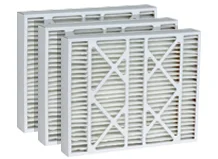Keeping the air in your space clean is crucial for your health, but picking the right air filter can be a puzzle. Let’s break down the ABCs of air filters: MERV (Minimum Efficiency Reporting Value), MPR (Microparticle Performance Rating), and FPR (Filter Performance Rating). These benchmarks are your navigational tools for identifying filters that effectively capture everything from household dust to pollen and smoke.
Key Takeaways
- Filter Efficiency Matters: Learn the specifics of MERV, MPR, and FPR ratings to choose a filter that captures pollutants effectively and suits your environment.
- MERV Ratings Explained: Dive into why MERV ratings are crucial for selecting the right filter, whether for residential comfort or meeting commercial air quality standards.
- Optimal Filter Selection: Understand the unique benefits of MERV 8, 11, and 13 filters offered by Filterbuy, and identify which level best meets your needs—whether it's for minimal allergen control at home or rigorous pollution management in hospitals.
- Comparative Insight: Assess how MERV, MPR, and FPR cater to different needs and environments, helping you navigate the best options for purchasing filters, whether from big box retailers or specialized providers
Understanding MERV Ratings
MERV (Minimum Efficiency Reporting Value) isn't merely technical jargon; it's your guide to selecting the perfect air filters, fitting for everything from cozy apartments to busy office spaces. Understanding MERV ratings is vital for maintaining indoor air that's both fresh and healthy.
Filterbuy boasts a range of air filters — MERV 8, MERV 11, and MERV 13 — each crafted to boost air quality wherever you are. Here’s how they break down:

MERV 8 Filters: Ideal for everyday residential use, MERV 8 filters are superb at capturing common air pollutants such as dust mites, pollen, and pet dander. They are an excellent choice for those upgrading from basic filters, designed to refresh your home's air efficiently without overburdening your HVAC system.
MERV 11 Filters: Looking for a bit more filtration strength? MERV 11 filters are tailored for environments with pets, smokers, or people with mild allergies. These filters excel at catching finer particles that might pass through a MERV 8, enhancing air purity and significantly improving the freshness of your indoor air.
MERV 13 Filters: Dealing with more demanding air quality needs? Whether it’s for a hospital, an office building, or just a super clean home environment, MERV 13 is up to the challenge. These filters are pros at removing over 90% of airborne particles—fine dust, bacteria, smoke, you name it. Need top-of-the-line filtration to ensure a healthy and comfortable space? Consider MERV 13 your go-to solution.
Each filter level is purpose-built to cater to specific needs, ensuring that whether your goal is to enhance residential comfort or achieve high commercial air quality standards, Filterbuy provides the perfect solution.
HAVE YOU MET YOUR MERV MATCH? TAKE THE QUIZ
Micron Size Chart: Why Filter Rating Systems Matter

It’s important to note that anything in the size range between .001 microns and 10 microns can reach deep into the lungs by being inhaled. Any particulates under around 100 microns can be inhaled into the nose.
The MERV, MPR, and FPR rating systems each consist of a range of numbers that represent the filtration effectiveness based on the micron size that it can filter out. Below, we’ll break down where the rating systems come from and how to use them when shopping for your next filter.
Comparing MERV, MPR, and FPR Ratings
Choosing the right air filter involves understanding how MERV, MPR, and FPR ratings compare. Each rating system serves a specific purpose and is tailored to different consumer needs.

MERV (Minimum Efficiency Reporting Value)
Origin: Developed by ASHRAE, this is the standard measurement in the air filtration industry, used widely in both residential and commercial settings.
Scale: 1-16, with higher ratings indicating better filtration capabilities for a broader range of particles, from dust to bacteria.
FPR (Filter Performance Rating)
Origin: Developed by The Home Depot for the brands sold in its stores, including popular ones like Honeywell.
Scale: 4-10, aligning closely with the MERV scale but tailored for Home Depot’s retail environment.
MPR (Microparticle Performance Rating)
Origin: Created by 3M, this rating emphasizes a filter's ability to capture fine particles that are harmful to health, such as smoke, smog, and microscopic allergens.
Scale: 300-2800, specifically measuring filtration efficiency for particles smaller than 1 micron.
Importance and Application
Each rating system addresses specific filtration needs:
- MERV is ideal for general use where a balance between air quality and system efficiency is needed. It’s recognized industry-wide and offers a reliable benchmark for filter performance.
- FPR offers a straightforward rating system for consumers shopping at Home Depot, making it easy to choose a filter based on simplified categories.
- MPR is particularly useful for residential settings where fine particle filtration is critical, such as homes with allergy sufferers or areas with high pollution levels.
The decision on which rating system to follow largely depends on individual needs and where the filters are being purchased. MERV offers widespread recognition and versatility across various settings, MPR provides detailed filtering of microparticles, and FPR simplifies the buying process for Home Depot customers. Understanding your specific air quality requirements and filter availability will guide you to the best choice for your environment.
Making the Right Choice with Filterbuy
The decision on which air filter rating system to follow should be guided by your specific air quality needs and where you plan to purchase your filters. MPR focuses on the detailed filtration of microparticles, suitable for environments where air purity is critical for health reasons. Meanwhile, FPR simplifies the selection process for customers shopping at Home Depot, offering a user-friendly approach to choosing filters. MERV is recognized widely for its versatility across various environments, making it a reliable choice for those seeking dependable air quality improvement.
Filterbuy provides air filters with higher MERV ratings, such as MERV 13, which significantly improve air quality by capturing finer particles. However, these higher ratings might affect airflow and the efficiency of your system. Consulting with an HVAC professional is advisable to help you choose the most suitable MERV rating. This ensures a balance between enhancing air quality and maintaining system performance.
Guide to FPR vs. MERV Air Filter Ratings
Deciding between FPR and MERV-rated air filters? Here’s a good way to compare FPR vs. MERV air filter ratings and capabilities.
- FPR 4 -5 is the same as MERV Ratings 6 – 8
- FPR 6 – 7 is the same as MERV Ratings 8 - 11
- FPR 8 – 9 is the same as MERV Rating 11
- FPR 10 is the same as MERV Ratings 13
Guide to MPR vs. MERV Air Filter Ratings
If you’re looking at air filters rated for MPR compared to air filters rated by the MERV filter rating system, you can reference this chart below:
- MPR 600 is equal to MERV Rating 8
- MPR 1000 is equal to MERV Rating 8
- MPR 1200+ is equal to MERV Rating 11
- MPR 1500 is equal to MERV Rating 11
- MPR 1550 is equal to MERV Rating 11
- MPR 1900 is equal to MERV Rating 11
- MPR 2200 is equal to MERV Rating 13
- MPR 2800 is equal to MERV Rating 13
FPR, MPR, and MERV Air Filter Rating FAQs
What does MERV stand for in air filter ratings?
MERV stands for Minimum Efficiency Rating Value, an industry-wide rating system used to determine how effective an air filter is at removing particles in the air. The system is based on the size of microns that can pass through the filter.
FPR stands for Filter Performance Rating, and it is a proprietary rating system for branded air filters sold by Home Depot and their air filters seem unique. While the FPR rating has no bearing on the overall efficacy of the air filter itself, the rating system isn’t as thorough as the MERV rating system, so it’s difficult to know exactly how efficacious an FPR-rated air filter is.
MPR stands for Microparticle Performance Rating, and it is a proprietary air filter ratings system created by 3M Their air filters seem like they have a unique rating and filtration ability. The MPR rating system goes from 100 up to 2200 and can cover a wide range of filtration capabilities. The rating system is generally comparable to the MERV rating system.
Here are the filtration comparisons between FPR and MERV:
- FPR 4 -5 is the same as MERV Ratings 6 – 8
- FPR 6 – 7 is the same as MERV Ratings 8 - 11
- FPR 8 – 9 is the same as MERV Rating 11
- FPR 10 is the same as MERV Ratings 13
High FPR (Filter Performance Rating) filters are often worth the investment, especially for individuals with allergies, respiratory issues, or pets in their homes. These filters are designed to capture a higher percentage of airborne particles, including dust, pollen, mold spores, and pet dander, compared to lower-rated filters. By improving indoor air quality, high FPR filters can contribute to a healthier living environment and may also protect HVAC systems from dust buildup, potentially extending their lifespan and improving efficiency. However, it's important to balance the need for high filtration with your HVAC system's capability, as overly restrictive filters can reduce airflow and system performance. Consulting with an HVAC professional to find the optimal FPR rating for your specific system and needs is advisable.
Here are the filtration comparisons between MPR and MERV-rated air filters:
- MPR 600 is equal to MERV Rating 8
- MPR 1000 is equal to MERV Rating 8
- MPR 1200+ is equal to MERV Rating 11
- MPR 1500 is equal to MERV Rating 11
- MPR 1550 is equal to MERV Rating 11
- MPR 1900 is equal to MERV Rating 11
- MPR 2200 is equal to MERV Rating 13
- MPR 2800 is equal to MERV Rating 13
We recommend utilizing a MERV 13-rated air filter for maximum filtration capabilities without taxing your central air system’s air flow capabilities. At a certain point, the MERV rating can get too high and cause your central air system to work much harder to push air through the filter.

.webp)
.webp)
.webp)
.webp)









